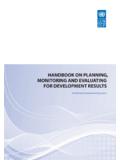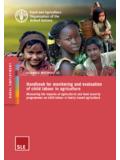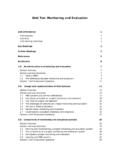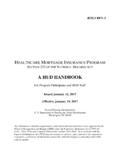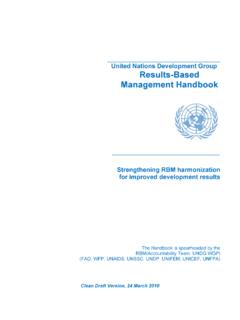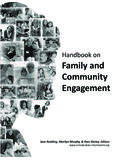Transcription of Handbook on Monitoring and Evaluation of Human …
1 With special applications for low- and middle-income countriesHandbook on Monitoring and Evaluation of Human Resources for HealthHandbook on Monitoring and Evaluation of Human Resources for Healthwith special applications for low- and middle-income countriesEdited by Mario R Dal Poz, Neeru Gupta, Estelle Quain and Agnes LB SoucatWHO Library Cataloguing-in-Publication DataHandbook on Monitoring and Evaluation of Human resources for health: with special applications for low- and middle-income countries / edited by Mario R Dal Poz .. [et al]. manpower. personnel administration and organization. personnel statistics and numerical data. management. analysis. countries. Poz, Mario R , Neeru. , Estelle , Agnes LB Health Organization. Bank. States. Agency for International 978 92 4 154770 3 (NLM classification: W 76) World Health Organization 2009 All rights reserved.
2 Publications of the World Health Organization can be obtained from WHO Press, World Health Organization, 20 Avenue Appia, 1211 Geneva 27, Switzerland (tel.: +41 22 791 3264; fax: +41 22 791 4857; e-mail: Requests for permission to reproduce or translate WHO publications whether for sale or for noncommercial distribution should be addressed to WHO Press, at the above address (fax: +41 22 791 4806; e-mail: The designations employed and the presentation of the material in this publication do not imply the expression of any opinion whatsoever on the part of the World Health Organization, World Bank or United States Agency for International Development concerning the legal status of any country, territory, city or area or of its authori-ties, or concerning the delimitation of its frontiers or boundaries.))
3 Dotted lines on maps represent approximate border lines for which there may not yet be full mention of specific companies or of certain manufacturers products does not imply that they are endorsed or recommended by the World Health Organization, World Bank or United States Agency for International Development in preference to others of a similar nature that are not mentioned. Errors and omissions excepted, the names of proprietary products are distinguished by initial capital reasonable precautions have been taken by the World Health Organization, World Bank and United States Agency for International Development to verify the information contained in this publication. However, the pub-lished material is being distributed without warranty of any kind, either expressed or implied.
4 The responsibility for the interpretation and use of the material lies with the reader. In no event shall the World Health Organization, World Bank or United States Agency for International Development be liable for damages arising from its named authors of each chapter alone are responsible for the views expressed in this : Front cover, left; back cover; pages 23 and 157: Curt Carnemark, World Bank. Front cover, center; and page 1: Ray Witlin, World Bank. Front cover, right; and page 61: Tran Thi Hoa, World Bank. Printed in India Editing, design and indexing by In s Communication: ContentsList of tables, figures and boxes ..viPreface ..xAcknowledgements ..xiList of contributors.. xiiAcronyms and abbreviations .. xiiiPart I: OVERVIEW ..1 1 Monitoring and Evaluation of Human resources for health: challenges and opportunities.
5 Introduction .. Global initiatives on HRH and information systems.. Key issues and challenges .. Framework for health workforce Monitoring : the working lifespan approach.. Road map.. Further information and comments .. 11 References..12 2 Boundaries of the health workforce: definition and classifications of health workers.. Introduction .. Who are health workers? .. Health workforce classification .. Summary and conclusions .. 21 References..22 Part II: Monitoring THE STAGES OF THE WORKING LIFESPAN..23 3 Monitoring the active health workforce: indicators, data sources and illustrative analysis.. Introduction .. Core indicators for HRH analysis: what needs to be monitored?.. Overview of potential data sources.. Illustrative analysis .. Putting it all together: governance and use of HRH information sources.
6 Summary and conclusions .. 34 References..36 Handbook on Monitoring and Evaluation of Human resources for healthiv 4 Framework and measurement issues for Monitoring entry into the health workforce.. Introduction .. Framework for Monitoring entry.. Measurement issues .. Summary and conclusions .. 47 References..47 5 Monitoring health workforce transitions and exits .. Introduction .. Transitions within and exits from the health workforce: a framework for analysis.. Indicators and measurement strategies .. Illustrative analyses .. Concluding remarks: implications for policy and planning .. 57 References..58 Part III: MEASUREMENT STRATEGIES AND CASE STUDIES .. 61 6 Measuring expenditure on the health workforce: concepts, data sources and methods.
7 Introduction .. What should be measured .. Approaches to measuring HRH expenditure .. Measurement frameworks and applications .. Summary, conclusions and further developments .. 76 References..77 7 Use of facility-based assessments in health workforce analysis .. Introduction .. 797. 2 How facility-based assessments can be used for health workforce Monitoring .. 807. 3 Overview of key HFA methodologies .. 817. 4 Some limitations of HFA methodologies for HRH data .. 857. 5 Empirical examples based on HFA data .. 867. 6 Summary and conclusions .. 98 References.. 100 8 Use of population census data for gender analysis of the health workforce .. Introduction .. Importance of gender considerations in health workforce analysis.
8 Using census data for health workforce analysis.. Empirical analysis.. Summary and conclusions ..110 References..111 Contentsv 9 Use of administrative data sources for health workforce analysis: multicountry experience in implementation of Human resources information systems.. Introduction .. Recommended first steps to develop a Human resources information system.. Country case studies .. Summary and conclusions .. 125 References.. 126 10 Understanding health workforce issues: a selective guide to the use of qualitative methods.. Introduction .. Qualitative methods: their value and potential.. Issues in the design and implementation of a qualitative study.. Summary and conclusions .. 143 References.. 144 11 Analysis and synthesis of information on Human resources for health from multiple sources: selected case studies.
9 Introduction ..14711. 2 Identification of potential information sources and their use to estimate indicators of health labour market participation in Mexico..14711. 3 Using multiple sources of information to produce best estimates of India s health workforce . Triangulation of data from two different sources for Monitoring health worker absenteeism and ghost workers in Zambia .. 15211. 5 Summary and conclusions .. 154 References.. 155 Part IV: DATA DISSEMINATION AND USE .. 157 12 Getting information and evidence into policy-making and practice: strategies and mechanisms. Introduction .. Strategies to get evidence into policy and practice .. A mechanism to harness the HRH agenda: health workforce observatories .. Opportunities and directions.
10 169 References..170 Index..173 About the publishing agencies ..176 Handbook on Monitoring and Evaluation of Human resources for healthvi List of tables, figures and boxesTABLEST able Framework for defining the health workforce..14 Table Relevant levels of education and training for health occupations according to the International Standard Classification of Education (ISCED-1997) .. 15 Table Fields of vocational training related to health according to Fields of training manual ..17 Table Occupational titles related to health according to the International Standard Classification of Occupations (ISCO), 1988 and 2008 revisions..18 Table Economic sectors related to health activities on the basis of the International Standard Industrial Classification of All Economic Activities (ISIC) Revision 4.










